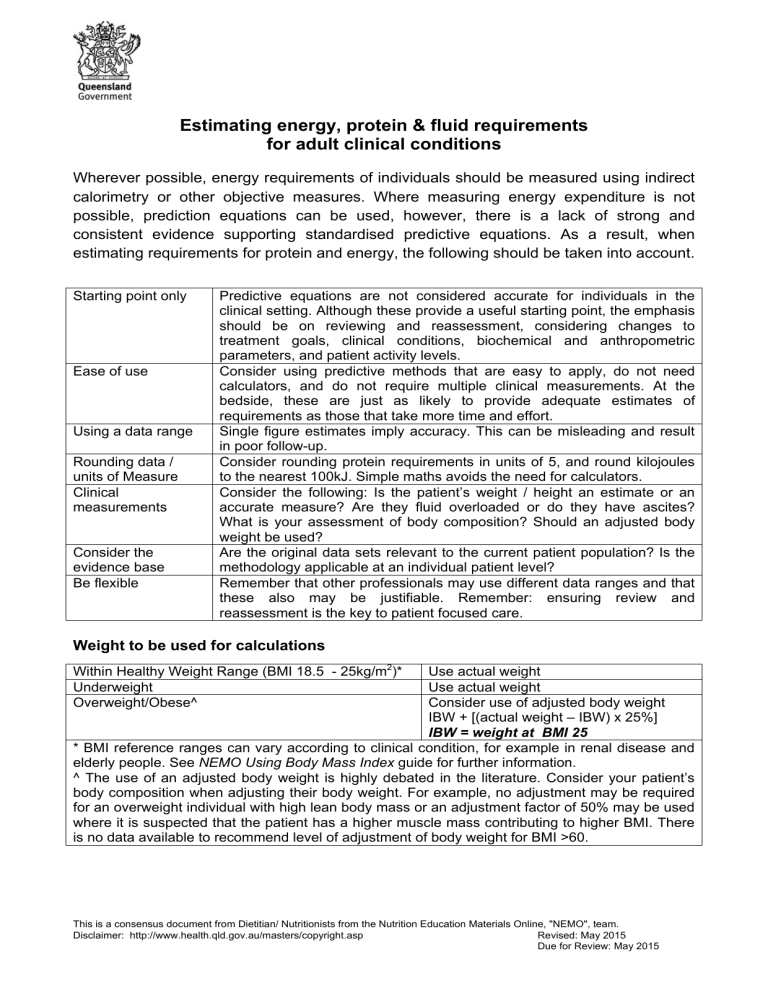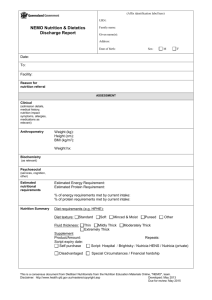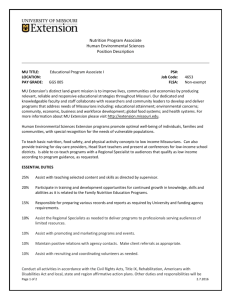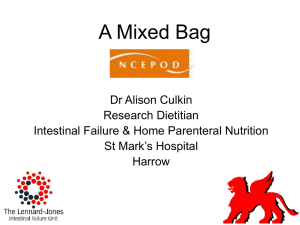Estimating energy, protein & fluid requirements for adult clinical

Estimating energy, protein & fluid requirements for adult clinical conditions
Wherever possible, energy requirements of individuals should be measured using indirect calorimetry or other objective measures. Where measuring energy expenditure is not possible, prediction equations can be used, however, there is a lack of strong and consistent evidence supporting standardised predictive equations. As a result, when estimating requirements for protein and energy, the following should be taken into account.
Starting point only Predictive equations are not considered accurate for individuals in the clinical setting. Although these provide a useful starting point, the emphasis should be on reviewing and reassessment, considering changes to treatment goals, clinical conditions, biochemical and anthropometric parameters, and patient activity levels.
Ease of use Consider using predictive methods that are easy to apply, do not need calculators, and do not require multiple clinical measurements. At the bedside, these are just as likely to provide adequate estimates of requirements as those that take more time and effort.
Using a data range Single figure estimates imply accuracy. This can be misleading and result in poor follow-up.
Rounding data / units of Measure
Clinical measurements
Consider the evidence base
Be flexible
Consider rounding protein requirements in units of 5, and round kilojoules to the nearest 100kJ. Simple maths avoids the need for calculators.
Consider the following: Is the patient’s weight / height an estimate or an accurate measure? Are they fluid overloaded or do they have ascites?
What is your assessment of body composition? Should an adjusted body weight be used?
Are the original data sets relevant to the current patient population? Is the methodology applicable at an individual patient level?
Remember that other professionals may use different data ranges and that these also may be justifiable. Remember: ensuring review and reassessment is the key to patient focused care.
Weight to be used for calculations
Within Healthy Weight Range (BMI 18.5 - 25kg/m 2 )* Use
Overweight/Obese^ Consider use of adjusted body weight
IBW + [(actual weight – IBW) x 25%]
IBW = weight at BMI 25
* BMI reference ranges can vary according to clinical condition, for example in renal disease and elderly people. See NEMO Using Body Mass Index guide for further information.
^ The use of an adjusted body weight is highly debated in the literature. Consider your patient’s body composition when adjusting their body weight. For example, no adjustment may be required for an overweight individual with high lean body mass or an adjustment factor of 50% may be used where it is suspected that the patient has a higher muscle mass contributing to higher BMI. There is no data available to recommend level of adjustment of body weight for BMI >60.
This is a consensus document from Dietitian/ Nutritionists from the Nutrition Education Materials Online, "NEMO", team.
Disclaimer: http://www.health.qld.gov.au/masters/copyright.asp Revised: May 2015
Due for Review: May 2015
Estimating energy, protein & fluid requirements
The following ‘ratio method’ equations for estimating energy, protein and fluid requirements have been collated from the available evidence-based guidelines and literature (see reference list). Please note that many of these equations are based on
‘expert opinion’ or have limited supporting evidence , in the available guidelines. The
Queensland Health NEMO Nutrition Support Group recommends these equations be used only as a starting point for establishing nutrition support, and that clinicians have a thorough understanding of their context within respective evidenced-based guidelines or literature. Regular ongoing monitoring and assessment to determine individual patient requirements is essential.
Patient category
Not hypermetabolic
Includes: CVA 1 , ulcerative colitis/Crohn’s 2
HIV/AIDS 3
Acute elderly patients 4-6
Adults 7 (not severely ill or injured, nor at risk of refeeding syndrome)
Moderately hypermetabolic
Includes : post-operative (~14days) 8,9
>38°, head injury 10, , multi-trauma
FTB/DPT), exacerbation COPD 13,14
XRT or chemoXRT 8,15
, repletion, infection, temperature
11 , BMT 12 , peritonitis, burns (10-20%
Pancreatitis 16,17
Pressure Injury 18,19
Cancer cachexia 20 (note: EPA 1.4-2g/day may be warranted)
Hypermetabolic
Includes : burns (>20% FTB/DPT) 21
Liver disease 22 (cirrhosis, alcoholic steatohepatitis,post-transplantation)
Hepatitis C 23
Cystic Fibrosis 24 120-150% usual requirements for age/gender
Anorexia nervosa / Refeeding risk
7, 25,26
This is a starting point only. Increase gradually
27
, monitoring relevant parameters for refeeding syndrome and overfeeding.
Renal (IBW = dry ABW if overweight)
28-30
Stage 3 CRF: GFR>30; Nephrotic (>3g urinary protein/day)
Stage 4 CRF: GFR<30
Haemo / IPD, CVVHD
CAPD (need to account for bag glucose in kJ)
Critically ill
31,32
During the acute and initial ‘ebb’ phase of critical illness, high energy intake may be associated with a less favourable outcome. This is a starting goal only and should be titrated up to meet higher requirements during the anabolic ‘flow’ phase.
Energy Protein kJ/kg kcal/kg g/kg
100-125
110-125
100-125
100-145
125-145
≥ 125
105-145
125-145
≥ 120
145-160
145-160
105-160
25-30
26-30
25-30
25-35
30-35
≥
30
25-35
30-35
30
0.8-1
0.8-1
1-1.5
0.8-1.5
1.2-1.5
≥ 1.2
1-1.5
1.25-1.5
≥ 1.4
35-40
35-40
25-40
1.5-2.0
1.2-1.5
≤ 4000kJ or 80kJ/kg
100-125
125-146
125-146
125-146
25-30
30-35
30-35
30-35
0.75-1
0.75-1
>1.1
>1.2
105-125 25-30 1.3-1.5
Adjusted weight
40 – 60kg
60 – 80kg
Fluid per day
1.5-2L
OR
30-35mL/kg 7 with allowances for extra losses via drains etc.
2-2.5L
-3L
Note: some caution should be used with elderly patients who may have reduced cardiac/renal function (20-25mL/kg 33 suggested starting
AI point for IV fluids)
2.1-2.6L of fluid per day for adults 34
References :
This is a consensus document from Dietitian/ Nutritionists from the Nutrition Education Materials Online, "NEMO", team.
Disclaimer: http://www.health.qld.gov.au/masters/copyright.asp Reviewed: May 2015
Due for review: May 2017
1. Foley, N., Teasell, R., Bhogal, S., Speechley, M. 2011. Nutrition Interventions following stroke, the Evidence-based review of stroke rehabilitation . http://www.ebrsr.com/reviews_details.php?10
2. Lochs, H., Dejong, C., Hammarqvist, F. et al. 2006. ESPEN Guidelines on Enteral Nutrition:
Gastroenterology.
Clinical Nutrition , 25: 260–274.
3. World Health Organisation. 2003. Nutrient requirements for people living with HIV/AIDS: report of a technical consultation, Geneva, 13–15 May 2003 . www.who.int/nutrition/publications/Content_nutrient_requirements.pdf
4. Alix, E., Berrut, G., Bore, M. et al. 2007. Energy requirements in hospitalized elderly people.
Journal of American Geriatrics Society , 55(7): 1085-1089.
5. Gaillard, C. Alix, E., Boirie, Y. et al. 2008. Are elderly hospitalized patients getting enough protein? Journal of the American Geriatrics Society, 56(6): 1045-1049.
6. Gaillard, C., Alix, E., Salle, A., Berrut, G., Ritz, P. 2007. Energy requirements in frail elderly people: A review of the literature. Clinical Nutrition, 26: 16-24.
7. NHS National Institute for Health and Clinical Excellence. 2006. Nutrition support in adults -
Oral nutrition support, enteral tube feeding and parenteral nutrition . http://www.nice.org.uk/CG32
8. Findlay, M., Bauer, J., Brown, T. et al. 2011. Evidence based practice guidelines for the nutritional management of adult patients with head and neck cancer.
Accessed via: http://www.cosa.org.au/
9. Braga, M., Ljungqvist, O., Soeters, P. et al. 2009. ESPEN Guidelines on Parenteral
Nutrition: Surgery. Clinical Nutrition , 28: 378-386.
10. The Brain Trauma Foundation, The American Association of Neurological Surgeons. 2007.
Guidelines for the management of severe traumatic brain injury.
Neurotrauma, 24(1): S77s82.
11. Jacobs, D., Jacobs, D., Kudsk, K. et al. 2004. Practice Management Guidelines for Nutrition
Support of the Trauma Patient.
Journal of Trauma, Injury, Infection and Critical Care , 57:
660-679 .
12. Arends, J., Bodoky, G., Bozzetti, F. et al. 2006. ESPEN Guidelines on Enteral Nutrition:
Non surgical oncology. Clinical Nutrition , 25: 245-259.
13. Anker, S., John, M., Pederson, P. et al. 2006. ESPEN guidelines on Enteral Nutrition:
Cardiology and Pulmonology.
Clinical Nutrition
, 25(2): 311-318.
PEN nutrition. 2013. Chronic Obstructive Pulmonary Disease: key practice points . www.pennutrition.com
15. Isenring, E., Hill, J., Davidson, W. et al. 2008. Evidence based practice guidelines for the nutritional management of patients receiving radiotherapy. Nutrition & Dietetics, 65(1): 1-
20.
16. Meier, R. Beglinger, G., Layer, P. et al. 2002. ESPEN guidelines on nutrition in acute pancreatitis. Clinical Nutrition , 21(2): 173-183.
17. Meier, R., Ockenga, J., Pertkiewicz, M. et al. 2006. ESPEN Guidelines on Enteral Nutrition:
Pancreas. Clinical Nutrition , 25: 275-284.
18. Trans Tasman Dietetic Wound Care Group. 2011. Evidence based practice guidelines for the dietetic management of adults with pressure injuries (Endorsed by DAA and Dietitians
NZ).
www.daa.asn.au
19. European Pressure Ulcer advisory panel and National pressure ulcer advisory panel. 2009.
Pressure Ulcer Treatment, Quick Reference Guide . www.npuap.org
20. Bauer, J., Ash, S., Davidson, W. et al. 2006. Evidence based practice guidelines for the nutritional management of cancer cachexia. Nutrition & Dietetics, 63(2): S5–S32.
21. Rousseau, A., Losser, M., Ichai, C., Berger, M. 2013. ESPEN endorsed recommendations:
Nutritional therapy in major burns. Clinical Nutrition , 32: 497-502.
22. Plauth, M., Cabre, E., Riggio, O. et al. 2006. ESPEN Guidelines on Enteral Nutrition: Liver disease. Clinical Nutrition, 25(2): 285-294.
23. PEN nutrition. 2008. Hepatic Disorders: Practice Questions . www.pennutrition.com
This is a consensus document from Dietitian/ Nutritionists from the Nutrition Education Materials Online, "NEMO", team.
Disclaimer: http://www.health.qld.gov.au/masters/copyright.asp Reviewed: May 2015
Due for review: May 2017
Australasian Clinical Practice Guidelines for Nutrition in Cystic Fibrosis.
http://daa.asn.au/wp-content/uploads/2012/09/Guidelines_CF-Final.pdf
25. Refeeding syndrome identification and management guideline . http://hi.bns.health.qld.gov.au/rbh/policies/guidelines/09407guid.pdf
26. Queensland Health, Eating Disorder Outreach service. 2012. Royal Brisbane and Women’s
Hospital Eating Disorder Outreach Service Initial Management Guidelines. http://hi.bns.health.qld.gov.au/mental_health/eating_disorder/documents/edos-manageguide.pdf
guidelines and discharge planning. http://hi.bns.health.qld.gov.au/mental_health/eating_disorder/documents/edos-ongo-manguide.pdf
28. Ash, S., Campbell, K., MacLaughlin, H. et al. 2005. Evidence Based Practice Guidelines for
Nutritional Management of Chronic Kidney Disease. Nutrition & Dietetics , 63(2): s33-45.
Requirements of Adults on Haemodialysis and Peritoneal Dialysis. https://www.bda.uk.com/publications/professional/rng_protein_executive_summary
30. PEN Nutrition. 2009. Nephrology – Chronic Kidney Disease: Non-Dialyzed (Adult): Key
Practice Points. http://www.pennutrition.com/KnowledgePathway.aspx?kpid=13817&pqcatid=146&pqid=13
844
31. Singer, P., Berger, M., Van den Berghe, G. et al. 2009. ESPEN guidelines on Parenteral
Nutrition: Intensive Care. Clinical Nutrition , 28: 387-400.
32. Kreymann, K. Berger, M., Deutz, N. et al. 2006. ESPEN guidelines on Enteral Nutrition:
Intensive Care. Clinical Nutrition , 25: 210-223.
33. National Institute for Health and Care Excellence. 2013. Intravenous fluid therapy in adults in hospital. http://www.nice.org.uk/guidance/cg174/evidence https://www.nrv.gov.au/sites/default/files/page_pdf/n35-water_0.pdf
This is a consensus document from Dietitian/ Nutritionists from the Nutrition Education Materials Online, "NEMO", team.
Disclaimer: http://www.health.qld.gov.au/masters/copyright.asp Reviewed: May 2015
Due for review: May 2017
Further Information
There is no evidence to support the use of ‘non-protein calories’ when using predictive methods to estimate energy requirements.
A number of equations have been developed to estimate basal or resting requirements in healthy subjects. Although not well evidenced, these are often combined with adjustment factors for the thermogenic effect of food, activity levels, and injury / disease state to estimate patient requirements. Most authors suggest multiplying BMR by activity factor, and then multiplying by injury factor, rather than adding the two together and then multiplying.
Advantages and disadvantages of key predictive equations are listed below. The NEMO Nutrition Support Group advocates the use of the Ratio Method for ease of initial application with a focus towards reviewing and reassessment.
Equation Comment
Ratio Method Provides an estimate of total energy requirements
Mifflin-St Jeor equation
Ireton-Jones equation
Provides an estimate of resting energy expenditure
Requires use of injury factors where relevant
Endorsed by the
American Dietetic
Association
Provides an estimate of total energy requirements
Developed for use in
Pros
Ease of use
No height required
Allows for different disease states
Very simple and easy to remember
More applicable to populations with increased obesity compared to
Harris Benedict Equation, Schofield
More relevant to current hospital patient population as recent data accounts for changes in medical management as well as shifts in
Cons
Does not take into account age or gender differences
Not evidence based for individual patient use
Does not take into account body composition although can be combined with adjusted body weight formula
Requires calculator
For patient use, requires incorporation of non evidence based injury factors
Original equation not designed to be used with injury factors
Individual variance in BMRs may be as high as 10%. Use
of activity and injury factors may accentuate this error height
Requires calculator
May tend to underestimate requirements for some patients
Assumes patients are only critically ill whilst
This is a consensus document from Dietitian/ Nutritionists from the Nutrition Education Materials Online, "NEMO", team.
Disclaimer: http://www.health.qld.gov.au/masters/copyright.asp Reviewed: May 2015
Due for review: May 2017
Schofield equations
Harris
Benedict equation
Toronto equation hospital patients
Provides estimates of
BMR.
Requires use of activity factors and injury factors where relevant
Provides an estimate of
BMR
Requires use of activity factors and injury factors where relevant
Burns specific equation population anthropometry/activity
Does not require height
Does not require injury or activity factors
Less likely to overestimate requirements for obese patients
Includes consideration for trauma, burns
BMR equation based on large data pool
Does not require height
Can allow for different disease states if injury factors applied
Most commonly used historically and internationally
Integrates many clinical affecting requirements ventilated
Does not allow for differences in burns / trauma severity
Does not allow for anabolic phase during convalescence
Assumes all obese patients have same body size and body weight
Requires calculator
Not evidence based for individual patient use
For patient use, requires incorporation of non evidence based injury factors
Original equation not designed to be used with injury factors
Individual variance in BMRs may be as high as 10%. Use of activity and injury factors may accentuate this error
Potential bias in data pool including many more men than women, high proportion fit young males, and differences in ambient temperature
Requires calculator
Not evidence based for individual patient use
For patient use, requires incorporation of non evidence based injury factors
Original equation not designed to be used with injury factors
Individual variance in BMRs may be as high as 10%. Use of activity and injury factors may accentuate this error
Has been noted to overestimate requirements when compared with indirect calorimetry
Requires
1919 data set predominantly young and lean and not considered relevant to Australian hospital patients
Requires calculator
Difficult to remember
This is a consensus document from Dietitian/ Nutritionists from the Nutrition Education Materials Online, "NEMO", team.
Disclaimer: http://www.health.qld.gov.au/masters/copyright.asp Reviewed: May 2015
Due for review: May 2017
Oxford
(Henry) equation
Penn State
University
Equation
Provides an estimate of total energy requirements
Being increasingly recommended for use in burns units
Uses the Mifflin-St Jeor equation with the addition of ventilation and maximum temperature.
Recommended by
ASPEN for use in Obese critically ill and hospitalised patients.
Provides an estimate of
BMR
Recommended by British
Dietetic Association
Parenteral and Enteral
Nutrition Group
Takes degree of burns into account
Good prediction accuracy in critically ill, obese patients
May be less likely to overestimate
BMR than Schofield equation
Data used in the development of this equation more representative of modern populations than Schofield equation
Time-consuming
Includes Harris Benedict equation
Requires accurate information on dietary intake
Formula based on studies using small cohorts
Requires
Requires calculator height
Minute ventilation data may not be routinely available
Requires calculator
Requires
May need further breakdown of elderly population groups
Requires use of activity factors which may multiply any errors
Further reading:
Allard, J., Pichard, C., Hoshino, E. et al. 1990. Validation of a new formula for calculation the energy requirements of burn patients. Journal of Parenteral and Enteral Nutrition
, 14(2): 115-118.
ASPEN Board of Directors and the Clinical Guidelines Task Force. 2002. Guidelines for the use of parenteral and enteral nutrition in adult and paediatric patients. Journal of Parenteral and Enteral Nutrition, 26: Suppl 1.
Boullata, J., Williams, J. et al. 2007. Accurate Determination of Energy Needs in Hospitalized Patients. J Am Diet Assoc , 107: 393-401.
This is a consensus document from Dietitian/ Nutritionists from the Nutrition Education Materials Online, "NEMO", team.
Disclaimer: http://www.health.qld.gov.au/masters/copyright.asp Reviewed: May 2015
Due for review: May 2017
Choban, P., Dickerson, R., Malone, A., Worthington, P., Compher, C., The American Society for Parenteral and Enteral Nutrition. 2013.
A.S.P.E.N. Clinical Guidelines: Nutrition Support of Hospitalized Adult Patients with Obesity. Journal of Parenteral and Enteral Nutrition ,
37(6): 714-744.
Henry, C. 2005. Basal metabolic rate studies in humans: measurement and development of new equations. Public Health Nutrition , 8(7A):
1133-1152.
Ferry S., Ward M. 2007. Back to basics: Estimating energy requirements for adult hospital patients.
Nutrition & Dietetics,
64: 192–199.
Mifflin, M.D., St Jeor, S.T., Hill, L.A. et al. 1990. A new predictive equation for resting energy expenditure in healthy individuals. Am J Clin
Nutr
, 51: 241–7.
Reeves, M., Capra, S. 2003. Predicting Energy Requirements in the clinical setting: are current methods evidence based. Nutrition
Reviews,
61: 143-151.
Royall, D., Fairholm, L., Peters, W. et al. 1994. Continuous measurement of energy expenditure in ventilated burn patients: An analysis.
Critical Care Medicine
, 22(3): 399-406.
Weijs, P., Kruizenga, H., et al. 2008. Validation of predictive equations for resting energy expenditure in adult outpatients and inpatients.
Clinical Nutrition, 27: 150-157.
This is a consensus document from Dietitian/ Nutritionists from the Nutrition Education Materials Online, "NEMO", team.
Disclaimer: http://www.health.qld.gov.au/masters/copyright.asp Reviewed: May 2015
Due for review: May 2017







